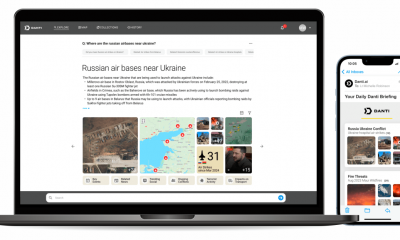Entertainment
How ‘Barbie’ became the American monoculture of the moment

It’s been a long time since a single piece of media has felt as visually ubiquitous or culturally inescapable as Barbie. The film has managed to break box office records and achieve a stunning omnipresence across politics, fashion, social media, news, and music. While the doll itself has been a household name for more than 60 years, Barbie has transcended mere popularity to become the single most dominant cultural topic in America right now, a veritable monoculture.
How has the must-see movie managed to capture our collective imagination and ire? We break it down below.
What is a monoculture?
In 2023, monoculture — a sociological term that can be used to describe a unifying event, value, goal that defines a group of people — is nearly mythological in the U.S. As our entertainment, politics, and identities have fractured, so has the culture.
The Olympics, for example, used to be a grand, uniting spectacle watched the world over. Now NBC, the exclusive broadcaster of the events, struggles with low U.S. viewership. American Idol drew 38 million American viewers at its peak, more than the entire population of California at the time. And while Europe can still unite over something like Eurovision, which drew in 162 million viewers in 2023, the U.S. has no equivalent. In 2017, The Ringer called Game of Thrones, which pulled in an average of 23 million viewers an episode, the “last vestige of the [television] monoculture.”
As for films, the closest we have is the Marvel franchise which, in the last 15 years, has claimed the 2nd, 6th, 7th, 10th, 14th, and 15th top grossing films of all time.
Barbie plays into post-pandemic nostalgia
The fear, sorrow, and loneliness of the pandemic prompted people to look toward the past, when life seemed less uncertain. As we navigate the post-pandemic (though not post-COVID) era, we are still craving the comfort of something familiar. That need has coincided with the resurgence of Y2K style and simpler forms of technology.
Barbie both intentionally and unintentionally leverages this pull towards the past, reuniting us with a figure that was, for most of us, a prominent presence in our childhood.
Pertinent politics contribute to a compelling narrative
Since her 1959 introduction, Barbie has been an inherently political figure, leveraged to serve both feminist and anti-feminist narratives (n.b. equal rights shouldn’t be a political issue, but the world we live in demands otherwise). Gerwig’s Barbie unpacks the dolls’ complicated narrative, making no qualms about the focus of the film: empowering women.
But to be truly monocultural, Barbie must also stir something in people who are not, let’s say, the film’s target audience. And their engagement with the movie doesn’t necessarily have to be positive. Right-wing thought leaders have decried the film, even calling to boycott it. Their discontent is part of what makes Barbie a movie for the masses.
Smart casting ensures nearly everyone has their own Barbie or Ken
Modern politics are identity politics, and Barbie makes a point of spotlighting a relatively diverse cast that reflects the makeup of the moviegoing audience.
The casting team cast a wide net, hiring actors from a range of media, including Ugly Betty and Superstore star America Ferrera, YouTuber-turned-acclaimed-showrunner Issa Rae, gay icon Kate McKinnon, trans it-girl model and actor Hari Nef, three (count ’em, three) members of the Netflix show Sex Education, and the heartthrob-of-the-2000s Ryan Gosling. The movie is packed with cameos that provide representation in addition to cheer-worthy Easter eggs.
The sheer size and breadth of the ensemble ensured that most people would see an actor they recognize in Barbie, and that Barbie-related material would be widely viewed across social media.
Musical masterstrokes make the soundtrack its own event
The Barbie soundtrack is stacked with hits and hitmakers, a strategy that all but ensured it mainstream radio play and heavy rotation on TikTok.
“Barbie World” by Nicki Minaj and Ice Spice, which samples Aqua’s 1997 hit “Barbie Girl” hit no. 7 on the Billboard Hot 100. Dua Lipa’s track for the album “Dance the Night Away” is sitting at no. 25 and climbing. Other artists include established acts like Billie Eilish, Lizzo, Charlie XCX, Karol G, Tame Impala, Khalid, HAIM, Sam Smith, and rising talent like PinkPantheress and FIFTY FIFTY.
Marketing that just doesn’t quit
To make Barbie feel like an inescapable cultural event, the marketing team got pretty literal, making sure Barbie was utterly ubiquitous. A dizzying number of branded collaborations — from a Progressive commercial to Barbie-themed Crocs, Pinkberry (and Coldstone), and even Google Searches — made Barbie and its signature pink practically pervasive.
Barbie‘s marketing team’s tireless work has made it to meme-status. Twitter users have been jokingly attributing unrelated pink-tinged events — like the spotting of a rare pink dolphin or a stunning peachy sunset — to the movie campaign.
#Barbenheimer on the brain
There’s no better free publicity than a meme taking on a life of its own. Barbenheimer is a portmanteau of Barbie and Oppenheimer, the Christopher Nolan film that premiered on the same day with a much darker subject matter. Online, the contrast between the technicolor Barbie and the brooding, atomic bomb-tell made for hilarious Twitter fodder. Offline, more than 200,000 people bought tickets to a Barbie-Oppenheimer double feature.
Barbiecore buzz has us thinking pink IRL
The combination of all these elements, and especially Barbie’s branded collabs with fashion retailers, has led to a boon in Barbie-fied apparel and decor. It’s not enough to see Barbie, we want to be Barbie. Shopping app LTK tells Mashable that it has seen a 644% increase in shopper searches for Barbiecore and Barbie in just the past week.
As a result, Instagram feeds and theater queues have been flooded with pink, as influencers and normal folks alike are inspired to express themselves in Barbie’s image. And the Barbiecore buzz is a tide that lifts a lot of different boats; LTK has seen a 21% increase in searches for Birkenstocks, which are mentioned in the film, since Barbie’s opening day.
We really are living in a Barbie world.
-

 Entertainment7 days ago
Entertainment7 days agoSummer Movie Preview: From ‘Alien’ and ‘Furiosa’ to ‘Deadpool and Wolverine’
-

 Entertainment6 days ago
Entertainment6 days agoWhat’s on the far side of the moon? Not darkness.
-

 Business7 days ago
Business7 days agoThoma Bravo to take UK cybersecurity company Darktrace private in $5B deal
-

 Business6 days ago
Business6 days agoHow Rubrik’s IPO paid off big for Greylock VC Asheem Chandna
-

 Business5 days ago
Business5 days agoTikTok faces a ban in the US, Tesla profits drop and healthcare data leaks
-

 Business5 days ago
Business5 days agoLondon’s first defense tech hackathon brings Ukraine war closer to the city’s startups
-

 Business6 days ago
Business6 days agoPhoto-sharing community EyeEm will license users’ photos to train AI if they don’t delete them
-

 Entertainment7 days ago
Entertainment7 days ago‘Challengers’ review: You’re not ready for Zendaya’s horny love-triangle drama




























